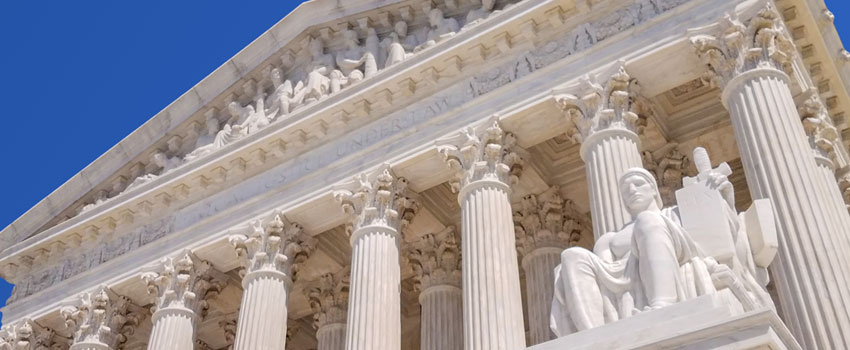Dr. Pate’s Prescription for Change
Trump’s Supreme Court nominee and possible impacts on health care

President Trump has made his pick to replace retiring Supreme Court Justice Anthony Kennedy. That pick is Judge Brett Kavanaugh, who sits on the U.S. Court of Appeals for the District of Columbia Circuit. This appointment requires Senate confirmation.
Senate resistance to Judge Kavanaugh from Democrats will likely largely center on the perceived threat to Roe v. Wade, the famous abortion case, because Judge Kavanaugh is a staunch conservative and President Trump has said he would put justices on the Supreme Court who would overturn Roe.
But what can we learn from the health care cases Judge Kavanaugh has decided to indicate how he might rule as a Supreme Court justice? Will the addition of Judge Kavanaugh to the bench increase the likelihood that the Affordable Care Act will be further dismantled or ruled unconstitutional?
Judge Kavanaugh ruled in a case that was the precursor to a constitutional challenge to the ACA heard in the Supreme Court and was widely criticized by conservatives. In their minds, his ruling was the basis for the Supreme Court’s decision to uphold the constitutionality of the ACA in another case by regarding the individual mandate as a tax.
The case was Seven-Sky v. Holder 661 F.3d 1 (2011). The lawsuit involved a challenge to the “minimum essential coverage” provision requiring people to purchase and maintain health care insurance or pay a penalty, commonly referred to as the individual mandate.
The taxpayers argued that the individual mandate exceeded Congress’ authority under the Commerce Clause in the U.S. Constitution. The U.S. District Court for the District of Columbia disagreed and upheld the provision as constitutional. The taxpayers then appealed the case to the U.S. Court of Appeals for the District of Columbia Circuit and that court upheld the decision of the lower court. Judge Kavanaugh wrote a dissenting opinion, indicating that the courts did not have the jurisdiction to decide the case.
The basis for Judge Kavanaugh’s dissent was a provision in the Tax Code called the Anti-Injunction Act (AIA), which prohibits a taxpayer from challenging an assessment or collection of taxes before the tax is enforced. In other words, a taxpayer challenging a tax law must first pay the disputed tax and then bring suit for a refund. This was important, because the case was being decided in 2011 and the individual mandate penalty would not be enforced until calendar year 2014 taxes were due in 2015.
While the majority distinguished the individual mandate penalty from a tax, Judge Kavanaugh construed the penalty to be a tax since Congress directed that the penalty be “assessed and collected in the same manner” as a tax. Judge Kavanaugh never reached the question as to whether the individual mandate penalty was constitutional because he construed the penalty to be a tax and therefore the court lacked jurisdiction to hear the case because the AIA applied and barred the lawsuit because the tax had not yet been enforced.
The point first raised by Judge Kavanaugh that the penalty was in fact a tax became the central argument in saving the ACA from being ruled unconstitutional by the Supreme Court in a case that challenged the constitutionality of the individual mandate that came before them the following year. The judicial reasoning of Judge Kavanaugh and Chief Justice John Roberts was very much aligned; Roberts has also received much criticism from conservatives for his ruling in the Supreme Court case, for which he was seen as the critical swing vote that saved the ACA from being ruled unconstitutional.
This ruling by Judge Kavanaugh signals that he favors judicial restraint as opposed to judicial activism. As he himself wrote, “For judges, there is a natural and understandable inclination to decide these weighty and historic constitutional questions.” He declined to decide the merits of the case, instead finding that the AIA barred suit.
He went on to write, “Notwithstanding the text of the Anti-Injunction Act, some have argued that compelling prudential considerations demand that the courts decide this constitutional issue now. But prudential considerations cannot trump the text of a statute setting forth limits on a court’s jurisdiction.”
In that same dissenting opinion, he wrote, “To uphold the Affordable Care Act’s mandatory-purchase requirement under the Commerce Clause, we would have to uphold a law that is unprecedented on the federal level in American history. That fact alone counsels the Judiciary to exercise great caution,” and “The significant implications of a Commerce Clause decision in this case – in either side’s favor – lead to this this point: If we need not decide the Commerce Clause issue now, we should not decide the Commerce Clause issue now.”
We also might conclude that he has great respect for the separation of powers principle. In this case, Judge Kavanaugh wrote that Congress exercised its powers to establish a jurisdictional limit on the court’s power and even though the executive branch might be willing to waive this jurisdictional limit, the court cannot accept that because Congress has not afforded the discretion to the executive branch to waive this jurisdictional bar.
In reading Judge Kavanaugh’s dissent, we can see evidence that the judge also has a respect for precedent, or the legal principle called stare decisis, meaning that when there has been a long history of the court interpreting law in a certain way, he will respect that and be loath to overturn it.
In a case involving an undocumented minor’s right to an abortion, Judge Kavanaugh wrote a dissenting opinion stating, “To be sure, this case presents a new situation not yet directly confronted by the Supreme Court. But that happens all the time. When it does, our job as lower court judges is to apply the precedents and principles articulated in Supreme Court decisions to the new situations.”
As further evidence of Judge Kavanaugh’s likelihood to follow precedent rather than his own beliefs and wishes, he wrote this – “It is undoubtedly the case that many Americans – including many Justices and judges – disagree with one or another aspect of the Supreme Court’s abortion jurisprudence.
From one perspective, some disagree with cases that allow the Government to impose regulations such as parental consent, informed consent, and waiting periods…. From the other perspective, some disagree with cases holding that the U.S. Constitution provides a right to an abortion. As a lower court, our job is to follow the law as it is, not as we might wish it to be.”
He also has often exercised deference to administrative agencies, citing expertise that these agencies have that courts do not. Writing in a case challenging FDA agency procedure, he indicated, “A court is ill-equipped to second-guess that kind of agency scientific judgment.”
On the other hand, Judge Kavanaugh did not hesitate to rule against an agency when it did not follow its own procedures, as he did in a 2014 case against the FDA, in fact, going on to scold the FDA for failure to discipline senior FDA officials for the agency’s lapses.
There is also evidence that Kavanaugh may be a textualist, looking to the actual words of the Constitution to derive the limits and meaning of the Constitution, and a strict constructionist, meaning that he does not read new concepts or rights into the Constitution beyond what is in the plain writing of the Constitution, along the lines of former Supreme Court Justice Antonin Scalia. For instance, Judge Kavanaugh upheld a ruling that terminally ill patients have no constitutional right to access unapproved medications.
After the president announced Judge Kavanaugh as his pick, Kavanaugh said, “My judicial philosophy is straightforward. A judge must be independent, must interpret the law, not make the law. A judge must interpret the statutes as written. A judge must interpret the Constitution as written, informed by history and tradition and precedent.”
Kavanaugh dissented in another case, one that involved a question of abortion rights (Garza v. Hargan 874 F.3d 735 (D.C.Cir. 2017) (en banc). In this particular case, the question was whether an undocumented immigrant minor should have access to an abortion. Arguing against that right, Judge Kavanaugh wrote, “The en banc majority, by contrast, reflects a philosophy that unlawful immigrant minors have a right to immediate abortion on demand, not to be interfered with even by Government efforts to help minors navigate what is undeniably a difficult situation by expeditiously transferring them to their sponsors.”
Kavanaugh stated his position – the government has “permissible interests in favoring fetal life, protecting the best interests of a minor, and refraining from facilitating an abortion,” and it “may further those interests so long as it does not impose an undue burden on a woman seeking an abortion.” He further acknowledged Roe v. Wade as binding precedent.
So, how might we expect Judge Kavanaugh to rule if he were appointed to the Supreme Court? There are a number of cases that could be on their way to the Supreme Court.
There is a case from the 7th Circuit Court of Appeals that ruled a state could not ban an abortion after a diagnosis of Down syndrome. If the state of Indiana decides to appeal that case and four justices agree to hear it, it will be before the Supreme Court. Judge Kavanaugh seems to be supportive of states’ rights, so he might side with Indiana, but he is also a big supporter of stare decisis and might therefore follow Supreme Court precedent and rule against the state for creating an undue burden on women seeking an abortion.
As for the ACA, the case is at the very early stages, but Texas et al. v. United States et al. (case 4:18-cv-00167-O filed 2/26/18) U.S. District Court, Northern District of Texas – Fort Worth Division, has major implications for health care, as Texas and 19 other states have asked the federal court to rule the ACA unconstitutional and invalidate the entire statute.
I have written about this case previously. Back in 2012, the Supreme Court addressed the constitutionality of the individual mandate and ruled 5-4 that it was a constitutional exercise of the taxing power. Now that the individual mandate penalty has been eliminated, the Texas case seeks to have the ACA ruled unconstitutional, since there is no valid tax to justify the implementation of the individual mandate.
If the case does go up to the Supreme Court, four justices would have to agree to hear it. After the criticism Chief Justice Roberts received for his tie-breaking vote in the 2012 case, he may not wish to revisit this issue, and it is unlikely that the other four in the majority would want the constitutionality of the ACA challenged. That then leaves the minority. One has died and another is Justice Anthony Kennedy, who by that time will be retired and potentially replaced by Judge Kavanaugh. Presumably, the remaining two justices, Samuel Alito and Clarence Thomas, would vote to hear the case.
It would then be up to the newest justice and Trump appointee, Neil Gorsuch, and Judge Kavanaugh if he is confirmed by then. As Trump appointees, I would expect that both would vote to hear the case and that would give the needed four votes. And then, if the Supreme Court does hear the case, will Chief Justice Roberts switch sides?
Finally, there are some mega-mergers being reviewed right now – CVS’ acquisition of Aetna and Walmart’s acquisition of Humana. There is very little jurisprudence regarding vertical mergers like these. The Trump administration seems to look at these deals unfavorably. There is the possibility that one or both could be challenged in court and make their way up to the Supreme Court.
Last year, the D.C. Circuit ruled against Anthem’s proposed acquisition of Cigna (a horizontal merger). The majority of the court sided with the lower court to block the deal on the grounds that it would substantially reduce competition.
Judge Kavanaugh dissented, indicating that the deal should be saved because it would create cost savings for consumers. “The merged Anthem-Cigna would be a more powerful purchasing agent than Anthem and Cigna operating independently,” he wrote. “The merged Anthem-Cigna would therefore be able to negotiate lower provider rates on behalf of its employer-customers. Those lower provider rates would mean cost savings that would be passed through directly to the employer-customers.”
Justice Kennedy in recent years has most often been the swing vote in 5-4 decisions. Judge Kavanaugh, if confirmed, is likely to be more consistently conservative in his votes.
About The Author

David C. Pate, M.D., J.D., previously served as president and CEO of St. Luke's Health System, based in Boise, Idaho. Dr. Pate joined the System in 2009 and retired in 2020. He received his medical degree from Baylor College of Medicine in Houston and his law degree from the University of Houston Law Center.



